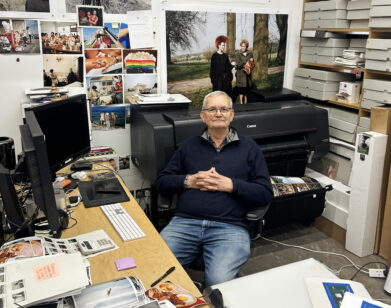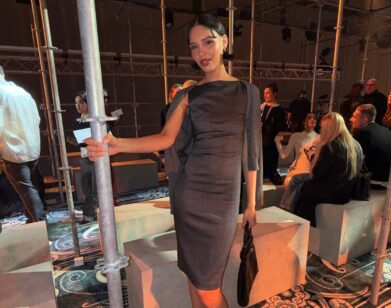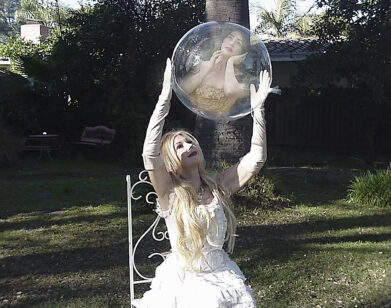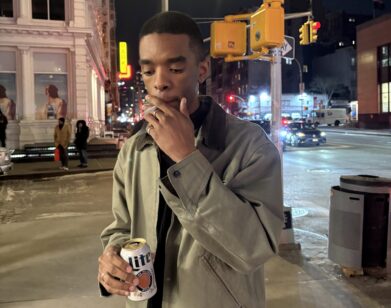Doug Jones, Unmasked
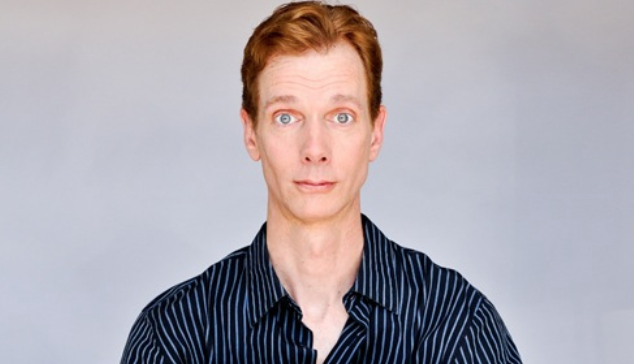
ABOVE: DOUG JONES. IMAGE BY J. REGAN HUTSON
Doug Jones has been in some big movies, but you probably wouldn’t recognize him on the street. Jones is one of the top “makeup actors” in the movie business, appearing head to toe in prosthetic pieces and elaborate costumes in films like Pan’s Labyrinth, Fantastic Four: The Rise of the Silver Surfer, Hellboy, and The Time Machine.
This summer, Jones portrays Cochise, an alien ally to the surviving humans in post-apocalypse Boston, in the third season of Falling Skies on TNT. We caught up with Jones out of the makeup chair to discuss the show, the perils of CGI, being an unrecognizable kind of famous, and cleverly captioned cat videos.
JAMES OSTIME: You’re currently appearing on TNT’s Falling Skies. How did you come to be cast in the series?
DOUG JONES: I’m a big fan of Falling Skies to start with, and I got a Facebook message from Todd Masters of Masters Effects, the creature effects creators for the entire show, saying “I’m working on this new character, an alien, for the show Falling Skies, are you interested?” I said, “Oh sure! Let’s have a look.” And that turned into an official call, back and forth between managers and production people, and all of a sudden, I’m on the show! So it was a rather casual beginning.
OSTIME: The show is a sci-fi series set in post-apocalyptic America, but with creator Robert Rodat (best known for writing Saving Private Ryan) and executive producer Steven Spielberg at the helm, the show is also so complex and layered—really character-driven and dramatic. You play Cochise, an alien. As an actor, how do you balance the fantastical elements of a character with the dramatic arc of a piece?
JONES: I think that’s the most appealing part of this role for me, is that all those parts are present. We do have the sci-fi fantastical, we have all the special effects that would give a geek goosebumps. We also have lots of family drama, survival drama, it’s all there. I entered the show in Season Three as a unique being. I’m the first alien on the show who looks the most human of any of them, I’m the most relatable alien they’ve come across, and I land with my people to help. I love so much that not only am I a sci-fi character, but there’s an element of human spirit and what I learn from humans, and that helps my character fight for himself this time. This entire show is a celebration of the human spirit, and we get to see that in fresh perspective from my character encountering humans for the first time. That gives me hope.
OSTIME: How long are you in the makeup chair every day on Falling Skies?
JONES: I’m like anybody would be, it’s not a process that I love, but it’s one that I know and that I’m used to. But if I’m going to be sitting at home, watching TV with a bowl of popcorn, I don’t want to be doing it with rubber makeup, do I? This makeup process is mercifully short, it’s only about two hours from head to toe. Considering that I’m used to doing five- to seven-hour makeups for TV and movie roles, this is ridiculously short. Happily short. My favorite thing to pass the time in the makeup chair is YouTube videos of talking cats. I don’t know why, but they make me laugh.
OSTIME: They make you laugh because they are hilarious, Doug.
JONES: Right, well, when they throw in the subtitles, it’s always funny.
OSTIME: Certainly. Now, I understand that the bottom half of Cochise’s mouth is your mouth, but there’s no way that your eyes line up with his. How can you see where you’re going?
JONES: Those beautiful golden eyes of Cochise are set higher and wider than my own. What I’m actually looking through are the wrinkles and vents of the nose area. So I can see in front of me okay, but I have no peripheral vision. I have to choreograph a scene and block it out for myself so I know the geography of the room so I confidently navigate the room with some sense of balance.
OSTIME: How difficult is it to play a scene with another actor, like Noah Wyle on the show, without being able to look them in the eye?
JONES: Well, I can look them in the eye just fine, but they can’t see mine. But it is kind of humorous to see another actor looking up at the golden eyes of the character; I know where they’re looking. I try to channel all my emotions through the eyes that they are looking at.
OSTIME: You’re in the strange position of having prominent roles in movies a lot of people have seen, like Pan’s Labyrinth, the Hellboy franchise, and Fantastic 4: The Rise of the Silver Surfer, all of which required you to be head to toe in makeup and prosthetics rendering you, the actor, unrecognizable from role to role. What’s it like to have the acting credits of a major movie star, but to not necessarily pay the same price of fame?
JONES: It is a glorious position to be in. I really get the best of both worlds. For instance, I was just at San Diego ComicCon last week and enjoyed myself very much because I was making several appearances and doing a lot of press there. Once they announce that I’m Doug Jones and this is what I’ve done, I get all the celebrity treatment anyone could ever want. But this week I can go to Starbucks and sit quietly and no one knows who I am. So when it needs to be turned on, it can be, and when I don’t need [the recognition], no one knows. It’s a great place to be in.
OSTIME: You began your career as a mime and contortionist. How do those disciplines help you when you create a character?
JONES: First of all, I can tell you a mime and contortionist is just plain sexy and does get the chicks.
OSTIME: Oh, I’m sure. [both laugh]
JONES: I learned mime back when I was in college, at Ball State University, Indiana. That woke up my body from the neck down and made me realize that acting and communication—portraying a story, event, or emotion—is a full-body experience. Body language, posturing, gestures, facial expressions, all these things come into play at least half, if not more than the verbal communication we do. Visual communication can be totally altered based on the physical communication that you’re giving. So the mime background plays a huge part in my sense of presence, physically. The contortion part, I’m kind of a one tricky pony in that area. I can put my legs behind my head, but that’s pretty much it. An early agent said to me, “If you can put your legs behind your head, let’s say you’re a contortionist!” So I got sent out for everything twisty and bendy. It’s a good conversation starter. You brought it up, anyway.
OSTIME: That’s true. [both laugh]
JONES: In the movie The Time Machine, for instance, with Guy Pearce, we filmed in 2001, if I remember correctly. The designers at Stan Winston Studios came up with the Spy Morlocks for that movie, and they made a small sculpture of that character, and they did him in a squatting position with the knees at such an angle, high up over the shoulders with a low bend. It was beautiful, but they looked at it and said, “Oh jeez! Who do we know who can do that?” And then I got a phone call. So it does come in handy.
OSTIME: Though you’ve played a number of otherworldly characters, you have appeared in some films as more or less a regular guy. Is an actor on set under 10 pounds of makeup and elaborate costume directed differently than an actor in a t-shirt and jeans?
JONES: Yes, I suppose so. It all depends on the director. Whether it’s t-shirt and jeans or full monster suit, I’m still an actor underneath it all, and a good director is going to know that. The director knows an actor needs his motivations, his place in the story, his relationship with other characters in the film. All of that has to be in place. The dimensions of the monsters and movement will alter the direction, especially if you have to create a special walk or movement that goes beyond human. That’s going to be an extra note you’ll get on set if it’s that type of movie.
OSTIME: Advances in CGI technology mean that some monsters, aliens, and other supernatural beings are created entirely in post-production. There’s sometimes nothing on set but a tennis ball that acts as a placeholder. What do you think a film or TV show loses when they opt for computer effects over a live performer?
JONES: I’ll give you the opinion that the fan base gives me, because I do so many convention appearances and have a lot of face-to-face interaction with the fans. They tell me that they prefer seeing a live human being in a costume. Humans like to watch other humans, period, whether it’s in makeup or not. They can appreciate the artwork that goes into computer graphics—it’s an art form unto itself, getting better all the time—but there’s something connectable when you actually have a live person. The true fanboys actually want to connect with another person, that’s what I’m told. Me personally, as an audience member, I can appreciate the artistry of both types. When it’s completely rendered by an artist with no live performers involved, sometimes it can look like you’re watching a video game. That takes you out of the film for just a second. What I love about the medium is when they can be combined.
OSTIME: You’re at a point in your career where you could choose to only do features and television, but I notice that you’ve appeared in a lot of short films, many by first-time directors. What is it about that experience that appeals to you?
JONES: I do an inordinate amount of short films and web series, all kinds of indie projects like that. Three things have to be present for me. There are jobs you do for the money, you have to pay the mortgage, but when I have time between those bigger productions, thanks to social media, Facebook, Twitter, LinkedIn, someone will contact me and say “I have this script, would you take a look at it, is this something you would want to consider doing?” And what has to be there is a story I want to help tell—does this entertain me, inspire me, make me think, make me laugh? Next would be the character itself. Is this a character I want to welcome into my heart, does this challenge me in a way that I’ve never been challenged before? And number three is the director. Whose hands am I going to be in creatively? Is this someone I trust? Oftentimes these have been first-time directors, and once you have a coffee date with that person or do a Skype with them, you get a lot of information from that conversational banter, you can find out what page he’s on. I’ve been lucky to find a lot of young talent that I appreciate, and if my appearance in their thing can help them on their journey, I’m happy to do that. And it would never hurt if they came back around to me when they do get there!
I just finished a short film shoot up in Utah for a young director named Jonathan Martin. It’s called Kiss the Devil in the Dark, and I play the devil. I met him at a film festival, where I watched his first short film, called An Evening with my Comatose Mother, which was disgusting and hilarious and unlike anything I had seen before. After the screening, I found him the lobby and tackled him and said, “Who are you? Let’s talk.” So this is how it happens.
OSTIME: Many actors, particularly in film and TV, have to worry about their age: how old they are determines the kind of roles they get, an actor at 20 has a very different choice of roles than an actor at 50. But you have played and continue to play strange creatures and mythical beasts throughout your career. What does longevity in this business mean to you?
JONES: As an actor in my 20s along with other actor friends, we were all worried, like, “If we don’t hit it big soon, you’re gonna miss the chance, it’s gone.” When I started getting roles under heavy prosthetic makeups and it was going on like that for a couple of decades, I was under the radar. Not a famous person but working consistently all these years. I started thinking, “Well maybe I’m not going to hit it big, maybe it’s not going to happen, and that’s fine!” But then, at 46 years old, Hellboy had already been out for awhile and then Pan’s Labyrinth was the page-turner for me. That’s when I went from weird creature guy and we’re not sure what else he’s done, to suddenly doing a lot of press and I was getting more work and the words “movie star” were finally coming into play, and I never expected that at age 46. I think what prosthetic and heavy makeups can afford an actor is timelessness and agelessness. This is something that Boris Karloff did until his gray and wrinkly years, so I’m hoping that I can do the same, and retirement is never really a word I have to operate.
THE SEASON THREE FINALE OF FALLING SKIES AIRS SUNDAY, AUGUST 4 AT 10 PM EST ON TNT.


